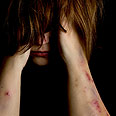
Unique study shines light on violence against haredi women
Domestic violence is a widespread phenomenon, but a first-of-its-kind study shows its unique characteristics within the religious-haredi sector
Domestic violence is a national epidemic that does not differentiate between sectors of the population, and yet, until recently no study has been conducted to examine the frequency of the phenomenon within the haredi sector.
Dr. Mally Schori-Biton, a criminologist and couples' therapist from Ariel University Center conducted a pioneer research that aimed to distinguish the phenomenon's unique characteristics within the religious and haredi sectors, while addressing a subject that was considered taboo for many years – violence against women.
The research will be presented during a conference in Bar Ilan University on June 20, which will host the top therapists in the haredi sector.
According to Dr. Schori-Biton, the phenomenon of violence against religious and haredi women has its own unique characteristics. "Because of the observance of modest dressing, there are more places where (the women) can be beaten without it being noticed, because the man is also concerned about what people will say.
"But there are also characteristics that have to do with the religious aspect," Dr. Schori-Biton noted, "Such as husbands that forced their women to wash their hands dozens of times in an obsessive manner, or humiliate them by mocking their level of religiosity.
"Sometimes physical violence is 'preferable' to humiliation or severe emotional abuse, which does not leave a physical mark or proof, and can lead to unbearable suffering," she said.
"This is true to the extent that some of the respondents said they preferred the beating to the verbal and emotional abuse. Some women also reported that their husbands forced them to have sex against their will – an act that is considered by law as rape with all its implications."
'Poverty can increase risk of violence'
Dr. Schori-Biton addressed the lack of research done on the domestic violence in the haredi sector, saying that "there is no statistical data to support the frequency of the phenomenon. There is data on certain communities and residential zones, but the level of religiosity is not a factor that is taken into consideration in the existing databases. And this is the basic problem that I encountered: The lack of a foundation that examines the phenomenon in this context."
The research used 88 battered women from the religious-haredi sectors as a case study, and all of them were interviewed by a haredi interviewer "that looks and dresses exactly like them, so that we can get a full and accurate picture," Dr. Schori-Biton said.
Half of the participants were haredi, while the rest considered themselves religious, and four were formerly religious-haredi. However, most of the participants did not change their level of religiosity as a result of the trauma.
Dr. Schori-Biton believes that financial status and poverty can increase the risk of domestic violence. "When there are financial crises, love flies out the window," she said, stressing that "it doesn’t mean every needy family suffers from violence, and this is only one factor out of a range of factors.
"The haredi society is characterized as a collective, patriarchal society, and social status is defined according to sex and hierarchy in the group. Like other closed societies, the haredi society exhibits deeply ingrained patterns of false appearances of 'everything is a-okay' alongside concerns over 'what others will say.'"
Social obstacles
Dr. Schori-Biton stressed that just as secular women find it difficult to break out of the cycle of violence and publicly declare that they are battered women, "the situation in the haredi society is much worse, because it involves defending the religious image and protecting the family at any price – even at the price of violence."
Out of all the shelters scattered across the country, only one treats battered religious or haredi women, Bat Melech.
So how do haredi women end up in shelters? Dr. Schori noted that 40% of respondents were directed to shelters by welfare authorities, while 16% were encouraged by family and friends and only 7% said they were referred to a shelter by their rabbis.
In the questionnaires, respondents said they silently suffered from abuse until they married their smallest child, and only then dared look for a shelter. They feared that treating the problem earlier would harm their children's prospects of marriage. Going to a shelter is considered by many of them as a socially unforgivable act, and therefore they wished to 'prepare the ground' for 'minimum impact.'"
According to the research's findings, the vast majority of women who turned to rehabilitation, managed to rebuild their lives and used sentences such as "I came back to life" and "I learned to appreciate and love everything in life" over and over again throughout the research.
Even fears of social rejection turned out to be exaggerated in most of the cases, and 30% indicated that in addition to strengthening relationships with family and friends, which were often sabotaged by the abusive husband, they have taken an active role in the communities where they live.
"We have seen a positive change in the past 15 years," said Dr. Schori-Biton, "Even among rabbis and 'socialization agents' within the communities that work with welfare offices. Awareness within the community has increased, and treatment centers that are suitable to the religious-haredi population have opened up. This is a sector that intends to battle the phenomenon. There is willingness and readiness, and all that is left to do is hope they succeed," she noted.










